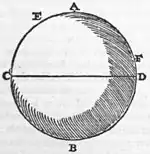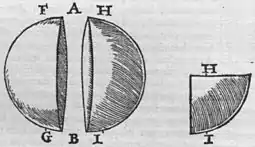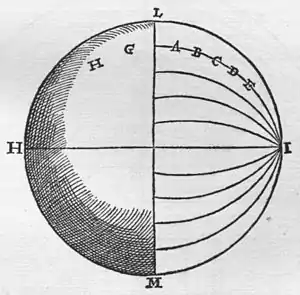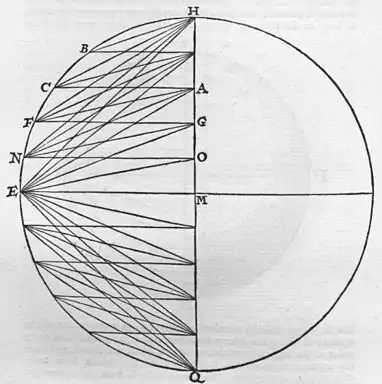CHAP. V.
How the Power dwells in the
Loadstone.


At C and D there is no force alluring magnetick ends to the body, for the forces tend toward both poles. But direction is powerful on the æquator. At C, D, the distances are equal from both poles; therefore iron which is at C, D, when it is allured in contrary ways, does not adhære with constancy; but it remains and is joined to the stone, if only it incline to the one or other side. At E there is a greater power of alluring than at F, because E is nearer the pole. This is not so because there is really greater virtue residing at the pole, but since all the parts are united in the whole, they direct their forces towards the pole. From the forces flowing from the plane of the æquinoctial towards the pole, the power increases. A fixed verticity exists at the pole, so long as the loadstone remains whole; if it is divided or broken, the verticity obtains other * positions in the parts into which it is divided. For the verticity always changes in consequence of any change in the mass, and for this cause, if the terrella be divided from A to B, so that there are two stones, the poles will not be A, B, in the divided parts, but F, G, and H, I.

Although these stones now are in agreement with one another, so that F would not seek H, yet if A was previously the boreal pole[163], F is now boreal, and H also boreal; for the verticity is not changed (as Baptista Porta incorrectly affirms in the fourth chapter of his seventh book); since, though F and H do not agree, so that the one would incline to the other, yet both turn to the same point of the horizon. If the hemisphere H I be divided into two quadrants, the one pole takes up its position in H, the other in I. The whole mass of the stone, as I have said, retains the site of its vertex constant; and any part of the stone, before it was cut out from the block[164], might have been the pole or vertex. But concerning this more under Direction. It is important now to comprehend and to keep firmly in mind that the vertices are strong on account of the force of the whole, so that (the command being, as it were, divided by the æquinoctial) all the forces on one side tend towards the north; but those of an opposite way towards the south, so long as the parts are united, as in the following demonstration.

For so, by an infinite number of curves from every point of the equator dividing the sphere into two equal parts, and from every point of the surface from the æquator towards the North, and from the æquator towards the Southern pole, the whole force tends asunder toward the poles. So the verticity is from the æquinoctial circle towards the pole in each direction. Such is the power reposed in the undivided stone. From A vigour is sent to B, from A, B, to C, from A, B, C, to D, and from them likewise to E. In like manner from G to H, and so forth, as long as the whole is united. But if a piece A B be cut out (although it is near the æquator), yet it will be as strong in its magnetical actions as C D or D E, if torn away from the whole in equal quantity. For no part excels in special worth in the whole mass except by what is owing to the other adjoining parts by which an absolute and perfect whole is attained.
Diagram of Magnetic Vigour
transmitted from the plane of the Æquator
to the peripherery of the terella
or of the earth

HEQ is a terrella, E a pole, M the centre, HMQ the æquinoctial plane. From every point of the æquinoctial plane vigour extends to the periphery, but by various methods; for from A the formal force is transmitted towards C, F, N, E, and to every point from C up to E, the pole; but not towards B; so neither from G towards C. The power of alluring is not strengthened in the part FHG from that which is in GMFE, but FGH increases the force in the eminence FE. So no force rises from the internal parts, from the lines parallel to the Axis above those parallels, but always inwards from the parallels to the pole. From every point of the plane of the equator force proceeds to the pole E, but the point F has its powers only from GH, and N from OH; but the pole E is strengthened from the whole plane HQ. Wherefore in it the mighty power excels (just as in a palace); but in the intermediate intervals (as in F) only so much force of alluring is exerted as the portion HG of the plane can contribute.
The page and line references given in these notes are in all cases first to the Latin edition of 1600, and secondly to the English edition of 1900.
163 ^ Page 73, line 2. Page 73, line 2. si A borealis.—The editions of 1628 and 1633 omit the twelve words next following.
164 ^ Page 73, line 9. Page 73, line 11. ex minera.—Minera is not a recognized word, even in late Latin. It occurs again, p. 97, line 12.